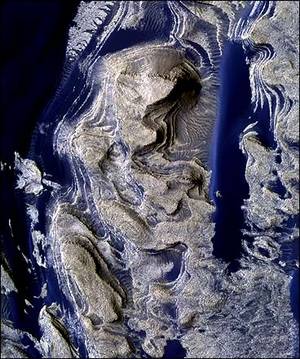Shots of the deep valley Candor Chasma show light coloured areas of rock where water could have flowed.
These "haloes" surround fractures in the Martian bedrock which provide a promising target in the search for evidence of past life on the planet.

|
| ©Science |
| Light-toned layered rock in Mars' Becquerel Crater. Layers show cyclic changes in thickness. The areas coloured blue are sand dunes. |
The images, published in Science journal, were taken by a camera aboard Nasa's Mars Reconnaissance Orbiter.
"It lends support to the idea that a substantial body of groundwater existed on Mars in the past and may still persist to the present day," said Professor Stephen Clifford of the Lunar and Planetary Institute in Houston, Texas.
"The fact that there is such persuasive evidence of joints and fractures in the crust also suggests that this groundwater had the ability to flow enormous distances."
The High Resolution Imaging Science Experiment (HiRise) camera started its surveys in November 2006, eight months after Mars Reconnaissance Orbiter (MRO) entered orbit around the Red Planet.
It is best known for capturing stunning images of Nasa's robot explorers Spirit and Opportunity as they surveyed the planet from the ground.
Nasa has recently admitted that some of the detectors on the camera are starting to fail.
The newly analysed images were taken last year. They show a snapshot of conditions in Candor Chasma, an area of the great Martian rift valley Valles Marineris.
This deep gash, the length of the United States, is up to seven times deeper than the Grand Canyon in places.
The images show a hilly landscape composed of alternating bands of light and dark coloured rock, suggesting the layers were deposited by regular cycles of water, wind or volcanic activity.
Cutting across the striped scenery, the researchers identified a network of cracks, known as joints, surrounded by prominent haloes of bleached rock.
Writing in Science, the University of Arizona team said that similar features on Earth were "a clear indication of chemical interactions between fluids circulating within the fracture and the host rock."
Likely fluids include water, liquid carbon dioxide or a combination of the two, and may have flowed up from deep underground reservoirs.
Previously, Europe's Mars Express mission had detected the signature of minerals altered by water in the Candor Chasma area.
The washed-out features, which have been "cemented" by minerals contained in the fluids, now stand proud from the valley walls.
This is not the first time that scientists have found evidence of fluids upwelling from deep inside the Martian crust.
Last year, Nasa's Mars Global Surveyor (MGS) spacecraft spotted gullies and trenches thought to have been recently carved by outpourings of water or liquid carbon dioxide.
Other features, including dried-up lake beds, springs and river valleys, lend further weight to the theory that the planet was once awash with water and could therefore have supported life.
Nasa is examining all of these sites as possible targets for future ground based robotic missions.
The Arizona team believes the areas of bleached rock should now also be added to this list.
The findings were presented at the American Association for the Advancement of Science (AAAS) annual meeting in San Francisco, US.



Reader Comments
to our Newsletter